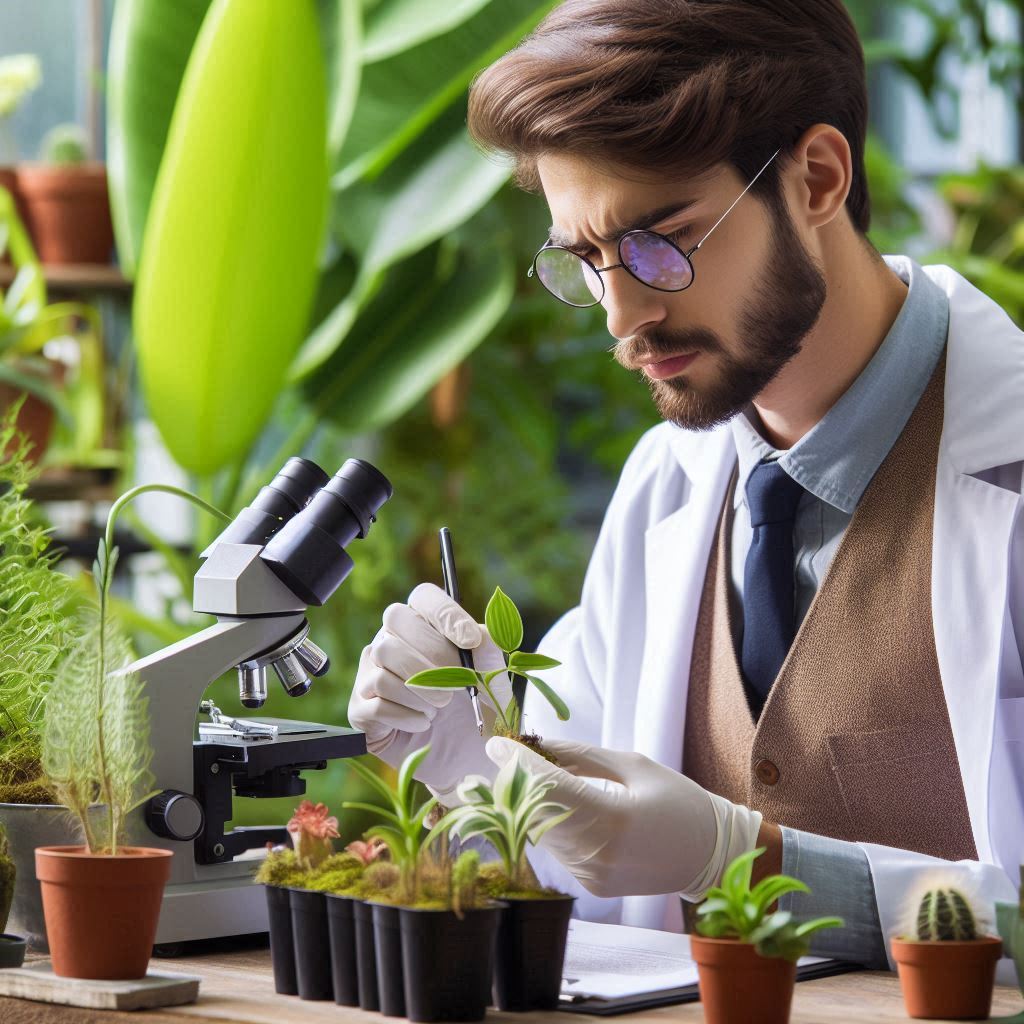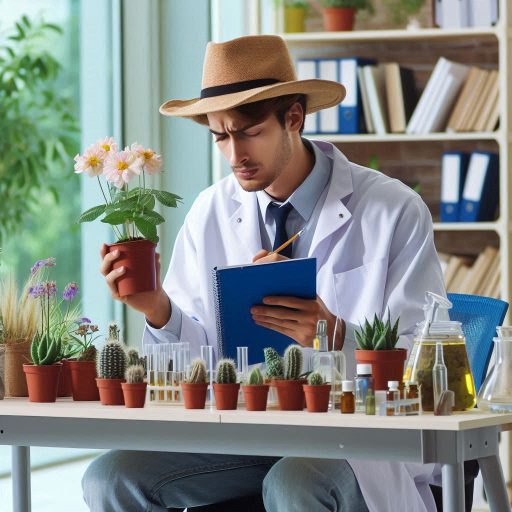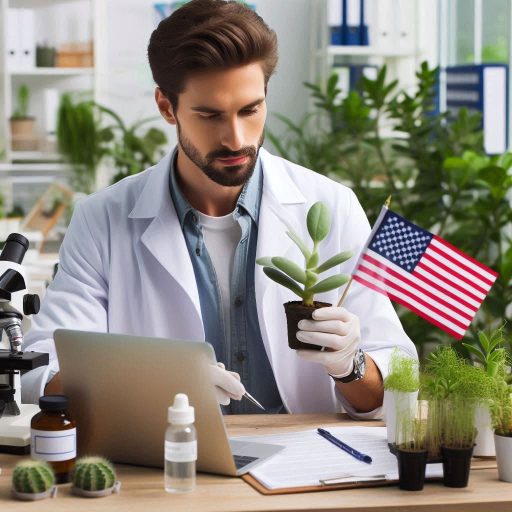Introduction
Botany is the scientific study of plant life, encompassing their structure, growth, reproduction, and ecology.
It explores the diversity of plants and their roles in ecosystems, focusing on everything from tiny algae to towering trees.
On the other hand, biotechnology applies scientific and engineering principles to manipulate biological systems for various applications.
This includes developing technologies that improve crops, create medicines, and enhance environmental practices.
These two fields intersect significantly, as advancements in biotechnology rely heavily on understanding plant biology.
Botanists provide essential knowledge about plant genetics, physiology, and ecology, which drives biotechnological innovations.
For instance, techniques like genetic engineering and tissue culture depend on a deep understanding of plant processes.
By applying this knowledge, scientists can modify plants to possess desirable traits, such as increased yield or resistance to pests and diseases.
Genetically modified organisms (GMOs) exemplify this synergy, enhancing crop resilience to environmental stressors and improving agricultural productivity.
The importance of studying the intersection of botany and biotechnology cannot be overstated.
To tackle global challenges like food security, climate change, and environmental degradation, we must develop innovative solutions.
History of Botany and Biotechnology
Origins of botany as a scientific discipline
Botany, the scientific study of plants, has ancient origins dating back to early civilizations.
Ancient Greeks, such as Theophrastus, made significant contributions to botany, laying the foundation for modern plant science.
Evolution of biotechnology as a branch of science
Biotechnology, on the other hand, is a relatively newer field that emerged in the 20th century.
It involves using biological systems and organisms to develop new products and technologies.
The biotechnological revolution began with the discovery of DNA structure and the development of genetic engineering techniques.
Key milestones in the development of both fields
Throughout history, there have been key milestones in the development of botany and biotechnology.
The invention of the microscope in the 17th century revolutionized the study of plants, allowing scientists to observe plant structures at the cellular level.
In the 20th century, scientists made advancements in genetics and molecular biology.
These breakthroughs led to innovations in biotechnology.
Researchers developed genetically modified crops and gene editing technologies.
The history of botany and biotechnology showcases continuous innovation and discovery.
Each field builds on previous knowledge and achievements.
Today, botany and biotechnology merge to tackle global challenges in food security, sustainability, and human health.
Scientists combine the strengths of plants and microorganisms to develop innovative solutions for a rapidly changing world.
Applications of Botany in Biotechnology
Botany plays a crucial role in the field of biotechnology, contributing to various aspects of research and development.
Here are some key applications of botany in biotechnology
Use of Plant Genetic Resources in Biotechnology
One of the primary applications of botany in biotechnology is the utilization of plant genetic resources.
Plants provide a wealth of genetic diversity that can be harnessed for various biotechnological applications.
Researchers and scientists often explore the genetic makeup of plants to identify genes of interest for further study.
This genetic information is then used in biotechnological processes such as gene editing, genetic modification, and molecular breeding.
Biotechnologists leverage plant genetic resources to develop improved crop varieties.
They enhance plant resilience to environmental stresses.
They also produce bioactive compounds for pharmaceutical purposes.
Role of Botany in Crop Improvement and Agriculture
Botany plays a significant role in crop improvement and agriculture by providing insights into plant physiology, growth patterns, and adaptation mechanisms.
Through the study of botanical principles, researchers can develop innovative agricultural practices, improve crop yields, and enhance food security.
Botanical knowledge is crucial in the development of new crop varieties that are resistant to pests, diseases, and adverse environmental conditions.
Botanists use biotechnological tools and techniques to breed plants with desired traits.
They aim for increased crop productivity, enhanced nutritional content, and improved shelf life.
Contribution of Botany to Pharmaceutical and Medical Research
Botany has made substantial contributions to pharmaceutical and medical research through the identification and isolation of bioactive compounds from plants.
Many drugs and medicines in use today have their origins in plant-based ingredients.
Botanical research has led to the discovery of numerous medicinal plants with therapeutic properties, ranging from pain relief to anti-cancer effects.
By studying plant compounds and their biological activities, researchers can uncover new drug candidates for the treatment of various diseases.
Biotechnological advancements allow researchers to extract, purify, and synthesize plant-based compounds.
These innovations pave the way for developing new drugs and therapies.
Basically, the integration of botany and biotechnology has opened up new avenues for scientific exploration and innovation.
Researchers can tackle pressing challenges in agriculture, medicine, and biotechnology.
They harness knowledge and resources from both fields effectively.
The applications of botany in biotechnology continue to evolve, driving advancements in crop improvement, pharmaceutical research, and sustainable development.
With ongoing collaboration between botanists and biotechnologists, we can unlock the full potential of plant-based solutions for a healthier and more sustainable future.
Read: US Chemistry Conferences and Symposiums to Attend in 2024
Biotechnological Techniques in Botany
Genetic Engineering and Plant Biotechnology
Genetic engineering revolutionizes how scientists approach plant breeding and development.
It involves altering an organism’s DNA to achieve desired traits.
This technique enables the creation of genetically modified organisms (GMOs) with specific characteristics.
These traits include increased resistance to pests, improved nutritional content, and enhanced growth rates.
Researchers use genetic engineering to address agricultural challenges.
For instance, they develop crops that withstand harsh environmental conditions.
These innovations contribute to food security and sustainable agriculture.
Moreover, genetic engineering allows scientists to study gene functions and interactions in plants.
This knowledge improves our understanding of plant biology.
Utilization of Molecular Tools in Botany
Molecular tools play a critical role in modern botany.
Techniques such as polymerase chain reaction (PCR) and DNA sequencing enable precise analysis of plant genes.
Scientists use these tools to identify genetic variations and track inheritance patterns.
This information is essential for breeding programs and conservation efforts.
Molecular markers help researchers select desirable traits in breeding.
These markers accelerate the development of improved plant varieties.
Additionally, scientists employ bioinformatics to analyze vast amounts of genetic data.
This analysis enhances our understanding of plant genomes and evolutionary relationships.
Moreover, molecular tools facilitate the study of plant responses to environmental stress.
By understanding how plants adapt at the molecular level, researchers can develop more resilient crops.
This research is vital for addressing climate change and ensuring sustainable agriculture.
Impact of Biotechnological Advancements on Plant Research
Biotechnological advancements significantly impact plant research and development.
They enhance our ability to study plant biology and improve agricultural practices.
For example, gene editing technologies like CRISPR allow precise modifications to plant genomes.
This technique enables targeted changes without introducing foreign DNA.
These advancements also support the development of biofuels and pharmaceuticals from plants.
Researchers can engineer plants to produce valuable compounds.
This innovation promotes sustainable production methods and reduces reliance on fossil fuels.
Furthermore, biotechnology fosters collaboration between disciplines.
Plant scientists, molecular biologists, and bioinformaticians work together to tackle complex challenges.
This interdisciplinary approach leads to innovative solutions for global issues such as food security and climate change.
The merger of botany and biotechnology is transforming our understanding of plants.
Genetic engineering, molecular tools, and biotechnological advancements enhance research capabilities.
These innovations lead to improved crop varieties, sustainable agricultural practices, and valuable applications in various industries.
As these fields continue to evolve, they hold great potential for addressing the pressing challenges facing our world today.
The integration of botany and biotechnology will shape the future of plant science and contribute to a more sustainable planet.
Read: Essential Skills and Tools for Modern Chemists in America

Environmental Implications of Botany and Biotechnology
Importance of plants in mitigating environmental issues
Plants play a crucial role in maintaining ecological balance by absorbing carbon dioxide during photosynthesis and releasing oxygen back into the atmosphere.
This process helps to reduce the levels of greenhouse gases in the atmosphere, which can help mitigate climate change.
Furthermore, plants also help in soil conservation by preventing erosion and improving soil fertility.
The roots of plants hold the soil together, reducing the chances of soil erosion caused by wind or water.
Additionally, plants contribute to nutrient cycling by releasing organic matter into the soil, which improves soil health.
In terms of biodiversity, plants provide habitats for various species of animals and insects, playing a key role in supporting the overall ecosystem.
By preserving plant species, we are also conserving the habitats of many other organisms that rely on them for survival.
Role of biotechnology in conservation and restoration efforts
Biotechnology offers innovative solutions for conserving and restoring plant species that are at risk of extinction.
Scientists propagate endangered plant species using techniques like tissue culture and genetic engineering.
These methods allow for growth in controlled environments, ensuring the plants’ survival for future generations.
Biotechnology plays a crucial role in restoring degraded ecosystems.
It introduces genetically modified plants that resist pests, diseases, and harsh environmental conditions.
These plants can help restore biodiversity and improve ecosystem services in areas that have been affected by human activities or natural disasters.
Transform Your Career Today
Unlock a personalized career strategy that drives real results. Get tailored advice and a roadmap designed just for you.
Start NowBiotechnology enhances the nutritional value of food crops.
It makes them more resilient to climate change and ensures food security.
This approach supports a growing global population.
Biotechnology helps reduce hunger and malnutrition by developing genetically modified crops.
These crops have increased yields and enhanced nutritional content, particularly benefiting developing countries.
Ethical considerations in using biotechnology for environmental purposes
While biotechnology offers promising solutions for environmental conservation, it also raises ethical concerns that need to be addressed.
One of the main ethical considerations is the potential impact of genetically modified organisms (GMOs) on native plant species and ecosystems.
GMOs can cross with native plants through gene flow.
This may lead to unintended consequences.
Genetic diversity could reduce, and invasive traits might enter natural environments.
Therefore, strict regulations and monitoring are necessary to prevent the spread of GMOs and minimize their impact on biodiversity.
Biotechnology products often have proprietary features, leading to ethical concerns. These concerns include access to genetic resources.
Additionally, they raise questions about fairly distributing benefits from biotechnological innovations.
Biotechnological advancements must benefit the environment and society.
They should not only serve the interests of a few corporations.
In review, the intersection of botany and biotechnology offers valuable opportunities for addressing environmental challenges and promoting sustainable development.
By harnessing the power of plants and biotechnological innovations, we can work towards a more resilient and biodiverse planet for future generations.
We must approach these advancements cautiously.
Prioritizing ethical considerations ensures they benefit nature and society responsibly.
Read: The Role of Chemists in US Environmental and Sustainability Efforts
Challenges and Opportunities in the Intersection of Botany and Biotechnology
As the fields of botany and biotechnology continue to converge, it is important to consider the challenges and opportunities that arise from this intersection.
Some of the key issues that researchers and scientists face include
Regulatory issues surrounding genetically modified organisms (GMOs)
Navigating the complex regulatory landscape surrounding genetically modified organisms poses a major challenge in botany and biotechnology.
Researchers must follow strict guidelines and regulations for using and distributing GMOs.
Compliance with these regulations helps them avoid potential legal issues.
Biotechnological applications offer opportunities to create GMOs that tackle critical challenges in agriculture.
These innovations can increase crop yields and enhance nutritional content.
They also improve plants’ resistance to pests and diseases.
Researchers can harness biotechnology’s power by understanding and working within the regulatory framework.
This approach enables them to develop innovative solutions for pressing problems.
Potential risks and benefits of biotechnological applications in botany
Another challenge in the intersection of botany and biotechnology is assessing the potential risks and benefits of using biotechnological applications in plant research.
Biotechnology can revolutionize agriculture and conservation efforts.
However, concerns exist about the long-term effects of introducing genetically modified organisms into the environment.
Researchers must carefully consider the ethical implications of their work.
They should take measures to minimize potential negative impacts on ecosystems and biodiversity.
Biotechnology offers clear benefits to botany.
It enables the creation of drought-resistant crops and develops novel medicines from plant sources.
Additionally, it helps conserve endangered species using innovative genetic engineering techniques.
Research gaps and areas for future exploration
Despite the challenges that exist in the intersection of botany and biotechnology, there are numerous opportunities for future exploration and research.
One key area for further study is the development of new biotechnological tools and techniques that can enhance our understanding of plant biology and ecology.
By investing in research and innovation, scientists can uncover new ways to conserve biodiversity, improve agricultural practices, and address pressing environmental issues.
Investing in interdisciplinary collaborations is crucial.
These partnerships unite experts from various fields.
Together, they tackle complex challenges at the intersection of botany and biotechnology.
Generally, while there are challenges and risks associated with the merging of botany and biotechnology.
There are also significant opportunities for innovation and discovery.
By addressing regulatory issues, assessing risks and benefits, and investing in research gaps.
Scientists can harness the power of biotechnology to revolutionize plant science and create a more sustainable future for our planet.
Read: Day in the Life: An Environmental Scientist’s Typical Day
Case Studies in Botany and Biotechnology
Botany and biotechnology have come together in various successful collaborations that have advanced plant science and biotechnology.
These case studies serve as examples of how different fields of science can work together to achieve remarkable results.
Examples of successful collaborations between botanists and biotechnologists
- Development of genetically modified crops with enhanced pest resistance
- Creation of novel plant varieties with improved nutritional content
- Utilization of biotechnological tools for conservation of endangered plant species
- Manipulation of plant genes for increased crop yields
- Use of biotechnology to study plant responses to environmental stressors
Impact of innovative research projects on plant science and biotechnology
The impact of these collaborations has been significant in advancing our understanding of plant biology and improving agricultural practices.
For example, the development of genetically modified crops has enabled farmers to increase productivity while reducing the use of chemical pesticides.
Furthermore, the creation of novel plant varieties with enhanced nutritional content has the potential to address malnutrition and food insecurity in developing countries.
This has far-reaching implications for global health and sustainability.
Lessons learned from these case studies for future interdisciplinary work
- Effective communication and collaboration between botanists and biotechnologists are essential for successful outcomes
- Interdisciplinary research projects require a deep understanding of both fields of science
- Ethical considerations must be at the forefront of any collaborative effort, especially when working with genetically modified organisms
- Investment in interdisciplinary research is crucial for addressing complex challenges in plant science and biotechnology
In fact, the merging of botany and biotechnology has opened up new possibilities for innovation and discovery in plant science.
By learning from these case studies and applying the lessons to future interdisciplinary work.
We can continue to push the boundaries of what is possible in agricultural and environmental research.
Conclusion
Merging botany and biotechnology creates significant opportunities for advancements in plant science and sustainability.
This collaboration enhances our ability to address global challenges, such as food security and environmental conservation.
By integrating knowledge from both fields, researchers can develop innovative solutions to improve crop yields, enhance plant resilience, and combat climate change.
The significance of this interdisciplinary approach cannot be overstated.
Biotechnological methods, such as genetic engineering and tissue culture, allow scientists to manipulate plant traits more efficiently.
These advancements lead to the development of crops that can withstand pests, diseases, and extreme weather conditions.
Furthermore, biotechnology plays a vital role in sustainable agriculture by reducing the need for harmful pesticides and fertilizers, ultimately benefiting the environment.
We encourage further research and collaboration between botanists and biotechnologists.
By sharing expertise across disciplines, researchers foster creativity and accelerate progress in tackling pressing issues facing our planet.
As we look ahead, interdisciplinary studies in plant science and biotechnology hold great promise for the future.
This fusion of knowledge will pave the way for exciting discoveries, such as biofuels from algae, phytoremediation techniques, and new methods for food preservation.
Transform Your Career Today
Unlock a personalized career strategy that drives real results. Get tailored advice and a roadmap designed just for you.
Start Now



